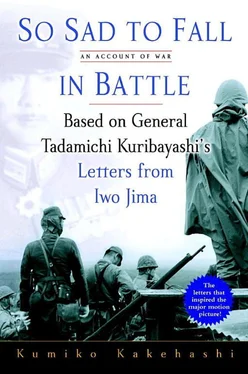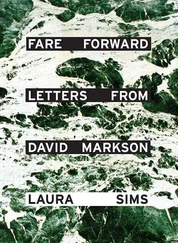The bones of Kuribayashi himself may be among them. It was then standard practice for the general to commit hara-kiri behind the lines during the final all-out attack that ended in death, but Kuribayashi broke this custom, too, when he led his men himself.
Impressed by the courage of the enemy general, the Americans tried to find his corpse once the battle was over, but could not since the Japanese had all removed the insignia from their uniforms. Kuribayashi chose the anonymous sleep of death somewhere in the depths of the island—just like the men he commanded.
IT WAS DECEMBER 2004 when I accompanied the families on their one-day memorial pilgrimage.
Proper memorial visits for the families of the dead started in the early 1970s. Different commemorative rites are conducted on Iwo Jima, but the organizer of the pilgrimage in which I took part was the Association of Iwo Jima, while a representative from the Ministry of Health, Labour and Welfare (the government department with oversight for such matters) came with us, and the Self-Defense Force provided assistance. Battle survivors and families of the dead established the Association of Iwo Jima in 1953, and this nongovernmental group has been diligently collecting the remains of the dead and organizing memorial activities ever since.
Present-day Iwo Jima has no real inhabitants. There are around 350 people from the Maritime and Air Self-Defense Forces permanently stationed there, plus a handful of staff from the Defense Facilities Administration Agency and construction company employees on the island for building projects.
The population was compulsorily evacuated in the summer of 1944, the year before the Americans invaded, to protect them from the horrors of war, and they were not permitted to return to the island even after it was returned to Japan. It was decided that a permanent settlement would be too difficult to maintain, given that the island has no industry of its own, and that fresh food and most other necessities have to be imported.
In consequence, there are no private houses on present-day Iwo Jima, nor, aside from a little kiosk inside the Self-Defense Force facility, is there a single shop. Families and people with a special connection to the dead are allowed to visit the island on memorial pilgrimages, and the former inhabitants are allowed to visit family graves. Otherwise ordinary people are technically not permitted to set foot on the place. The whole island really is a military base now.
The Japanese military ordered that Iwo Jima be defended to the death because it was an “unsinkable aircraft carrier” on the Pacific Ocean. That designation may be even more appropriate now when there is nothing there apart from the airfield and the facilities that go with it.
After disembarking from the plane, the families climbed into a number of cars and headed to the northeast corner of the island, where the Tenzan Memorial stands.
The paved road that runs around the island is surrounded by greenery, but maybe because Iwo Jima is a volcanic island where the smell of sulfur always hangs in the air—or maybe because of the strong salt breeze that blows nonstop from the sea—there is none of the luxuriant jungle one associates with South Sea islands, just masses of stunted, shrublike trees.
The Americans are supposed to have fired so many shells and bombs into the island that the total volume of metal would cover the island in a steel sheet one meter thick. All of the island’s animal and plant life was incinerated, and now the most flourishing plant on the island is the lead tree, a kind of arborescent shrub.
The lead tree is not indigenous to Iwo Jima. After the Americans had captured the island, they spread great quantities of seeds from airplanes. It is suggested that they deliberately chose a plant that takes root and grows quickly in order to wipe out the stench from the exposed corpses of the Japanese soldiers.
A memorial service was held on Tenzan, a small hill exposed to the strong winds that blow in from the sea. One after another, the family members walked up to the memorial stone to douse it with water that they had brought with them from their hometowns in canteens or plastic bottles.
Fifty family members took part. The widows were from their late seventies to their eighties; the youngest of the children of the dead was a woman of fifty-nine who had still been in her mother’s womb when her father went off to war.
The participants also included people who were not strictly family.
“My husband died ten years ago. He was transferred from here back to the mainland before the Americans invaded, and right up until he died he was tortured by the fact that he survived while almost all the men under him were killed. My husband always said that he wanted to come here to pay his respects, but was unable to fulfill his wish. That’s why my daughter and I are here today.”
The wife was seventy-seven years old, the daughter fifty-two. They had brought a photograph of their husband/father with them and they spent a long time in prayer in front of the memorial.
We then climbed back into the station wagons and microbuses and headed for the interior of the island. In advance, the Association of Iwo Jima had checked the whereabouts on the island of the men who had died based on which part of Japan they came from and the names of their units.
The family members all asked if they could visit the places where their relatives had died to offer incense and prayer, but time was limited as our return plane was due to leave a little after 4:00 p.m.
Covered in shrubs and weeds, Iwo Jima appears flat at first glance, but as it is a volcanic island the terrain is extremely uneven. A single misstep can mean a nasty fall—the bunkers themselves are often concealed. In some rocky areas, steam spewing out at high temperatures means that venturing off the paved road is dangerous.
Even if you knew that the unit to which your husband, father, or brother belonged was stationed just a little way away, getting in closer was forbidden; only paying homage from the roadside or from inside the car was permitted.
“Please, let me get closer. Thirty seconds is all I need. Let me get out of the car to offer incense.”
I could hear voices imploring the driver, an older man dressed in a very proper suit despite the beating sun. The voices contained sixty years’ worth of grief—the grief of people who had at long last made it to the place where their relatives had died.
KURIBAYASHI’S COMMAND BUNKER was situated in the north of the island.
He chose this place as the site of his final resistance on the assumption that the Americans would work their way up the island from south to north, which was precisely what happened. The bunker is at the extreme tip of the island: to the north there is only the shore running from Onsen Hama to Kita no Hana.
Surrounded by higher ground, the bunker nestles within a horseshoe-shaped rise. The entrance is visible at the base of the low bluff of light brown rock. You would need to stoop a little to go inside. At the time, of course, it would have been thoroughly camouflaged.
I peered in, but couldn’t see far into the dark cave; a few rusty steel rods stuck out of the cement still framing the doorway in places. The ground underfoot was slippery and sloped downward, leading to a flight of stairs. After going down them a while, the passageway suddenly grew much smaller. I was walking hunched and with my knees bent but my back was still scraping on the roof. No light from outside reached this far inside, and moving forward without a flashlight was out of the question.
After I had walked a few meters, the passage made a sharp turn to the left and led to a small room with a floor area equivalent to about six tatami mats. Sturdily built and reinforced with concrete, this was Kuribayashi’s private room.
Читать дальше












